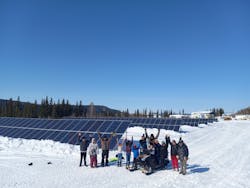When the solar, storage and diesel microgrid in Hughes, Alaska, first began working solely on solar in 2021, First Chief Wilmer Beatus asked why his lights were still working.
Beatus asked this question because he could no longer hear the sound of diesel generators, said Eddie Dellamary, rural energy specialist at Tanana Chiefs Conference, a nonprofit corporation that provides services to tribes in Alaska.
After more than six years, the isolated town – located 210 air miles northwest of Fairbanks – had begun to reach its goal of increasing the number of “diesel off” hours.
This was a critical milestone because diesel has to be flown in and costs as much as 90 cents/kWh.
“Due to the uncertainty of global oil prices and other factors, diesel prices affected this community of 70 people who want to continue to live life as they have since the dawn of modern man,” said Dellamary.
Small towns in Alaska seek ‘diesel off’
Like Hughes, many small towns in Alaska are striving to turn off their diesel generators as often as possible, replacing them with renewable energy and storage.
The majority of power systems in Alaska are not connected to the transmission grid. They are generally microgrids that range in size from a few kilowatts to multiple megawatts and include a mix of energy resources – both clean renewable and fossil fuel-based generation, according to Mayank Panwar, senior research engineer at the National Renewable Energy Laboratory (NREL), which is working in Cordova, Alaska, and other towns to improve on existing microgrids.
“Recently, a major push has been to move away from fossil-based clean energy as a sustainable alternative without compromising reliability and resilience,” Panwar said.
Hughes was early adopter of renewables
The town of Hughes began its journey toward the use of renewables earlier than most, said Dellamary. In 2016, the Hughes Village Council, supported by the Tanana Chiefs Conference energy program, received about $1.2 million in funding from the federal Department of Energy’s Office of Indian Energy to add solar and storage to its off-grid diesel microgrid. The project was launched by Beatus, who wanted to move toward greener energy.
In 2020, the town began installing a 120-kW solar array and 337-kWh battery system to the existing diesel microgrid and, by the fall of 2021, the microgrid was operating four to five hours a day without diesel.
That year, the solar array produced over 44,000 KWh, which was about 9.5% of the total electrical output for Hughes, Dellamary said.
But town officials knew they could do even better and asked Ageto Energy – which provided the microgrid controls – to tweak the microgrid to squeeze out more solar and battery power and add additional hours of “diesel off.”
At the time, the battery was overdischarging, which can undermine battery life, and there wasn’t any visibility into the system, said Laura Williams, application engineer for Ageto Energy.
Empowering citizens to take control of their energy
To Williams, operating the microgrid as efficiently as possible was critical to the town.
“These folks have been living there for a long time affected by climate change. They also run diesel which contributes to climate change. It’s a weird paradox. Bringing in renewables empowered them to take control of their energy,” she said.
The Ageto control system makes decisions based on real-time data. Before the retrofit of the controls, the diesel generators started daily at 7 p.m. Now the system is automated, and the Ageto controls decide when to start up the generators based on how much capacity is available in the batteries. That shifted the generator “on” time to after midnight. In the summer, the town is cutting out about 11 hours of diesel generator runtime daily, said Williams.
Many Alaskan towns are seeking to use less diesel, said Panwar. NREL is lending a helping hand, beginning in Cordova, which is located on Prince William Sound in the Gulf of Alaska and has a microgrid that includes 7.5 MW of hydro, 11 MW of diesel and 1 MWh of battery storage.
NREL’s grid sensors help Cordova prioritize loads during emergencies
NREL provided high-resolution grid sensors to understand the electrical dynamics of the existing microgrid in Cordova, and it utilized that data to evaluate different energy technologies that may work well in the microgrid.
“Good quality monitoring and field data also helps in technology integration and operations,” said Panwar.
One challenge: Cordova’s electrical system couldn’t prioritize loads.
In case of an emergency or resilience event, an individual feeder can trip and interrupt service to all feeder loads, both critical and noncritical, he said.
NREL’s advanced sensing and controls provided better visibility into the whole grid to maximize service to critical loads, he said. Advanced metering provided opportunities to prioritize loads such as a hospital. And now, the system can reconfigure automatically, responding to extreme events and taking into account load priorities.
The benefits of a digital twin of Cordova’s microgrid
NREL also created a real-time digital twin of the Cordova microgrid, which allowed NREL to identify any grid instability problems in real time.
While NREL created this approach with Cordova, other utilities and cooperatives can utilize a similar strategy, with a goal of de-risking distribution system investments. A digital twin can help utilities understand the implications of technology upgrades. This reduces technology deployment risks by evaluating options in a controlled lab environment, said Panwar.
In addition to gleaning information from the Cordova experience, other Alaska communities can learn from the experience in Hughes, said Dellamary.
“They can learn all things are possible. Solar and other renewables are viable options now more than ever. It’s a fantastic time to invest,” Dellamary said.








